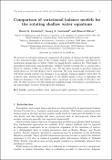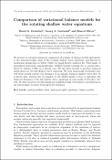Files in this item
Comparison of variational balance models for the rotating shallow water equations
Item metadata
| dc.contributor.author | Dritschel, David Gerard | |
| dc.contributor.author | Gottwald, Georg | |
| dc.contributor.author | Oliver, Marcel | |
| dc.date.accessioned | 2017-06-28T11:30:15Z | |
| dc.date.available | 2017-06-28T11:30:15Z | |
| dc.date.issued | 2017-07-10 | |
| dc.identifier | 250361143 | |
| dc.identifier | 90f051df-1d79-42c5-bf23-1a1ca504b614 | |
| dc.identifier | 85020623645 | |
| dc.identifier | 000403090300033 | |
| dc.identifier.citation | Dritschel , D G , Gottwald , G & Oliver , M 2017 , ' Comparison of variational balance models for the rotating shallow water equations ' , Journal of Fluid Mechanics , vol. 822 , pp. 689-716 . https://doi.org/10.1017/jfm.2017.292 | en |
| dc.identifier.issn | 0022-1120 | |
| dc.identifier.other | ORCID: /0000-0001-6489-3395/work/64697782 | |
| dc.identifier.uri | https://hdl.handle.net/10023/11100 | |
| dc.description | Funding through the TRR 181 is gratefully acknowledged. GAG’s initial work was funded by the Australian Research Council grant DP0452147. All three authors received support for this research from the UK Engineering and Physical Sciences Research Council (grant number EP/H001794/1). | en |
| dc.description.abstract | We present an extensive numerical comparison of a family of balance models appropriate to the semi-geostrophic limit of the rotating shallow water equations, and derived by variational asymptotics in Oliver (J. Fluid Mech., vol. 551, 2006, pp. 197–234) for small Rossby numbers Ro . This family of generalized large-scale semi-geostrophic (GLSG) models contains the L 1-model introduced by Salmon (J. Fluid. Mech., vol. 132, 1983, pp. 431-444) as a special case. We use these models to produce balanced initial states for the full shallow water equations. We then numerically investigate how well these models capture the dynamics of an initially balanced shallow water flow. It is shown that, whereas the L 1-member of the GLSG family is able to reproduce the balanced dynamics of the full shallow water equations on time scales of O ( 1/Ro ) very well, all other members develop significant unphysical high wavenumber contributions in the ageostrophic vorticity which spoil the dynamics. | |
| dc.format.extent | 28 | |
| dc.format.extent | 7049443 | |
| dc.format.extent | 7049443 | |
| dc.language.iso | eng | |
| dc.relation.ispartof | Journal of Fluid Mechanics | en |
| dc.subject | Rotating flows | en |
| dc.subject | Shallow water flows | en |
| dc.subject | Variational methods | en |
| dc.subject | QA Mathematics | en |
| dc.subject | QC Physics | en |
| dc.subject | NDAS | en |
| dc.subject | BDC | en |
| dc.subject | R2C | en |
| dc.subject.lcc | QA | en |
| dc.subject.lcc | QC | en |
| dc.title | Comparison of variational balance models for the rotating shallow water equations | en |
| dc.type | Journal article | en |
| dc.contributor.sponsor | EPSRC | en |
| dc.contributor.institution | University of St Andrews. Applied Mathematics | en |
| dc.contributor.institution | University of St Andrews. Marine Alliance for Science & Technology Scotland | en |
| dc.contributor.institution | University of St Andrews. Scottish Oceans Institute | en |
| dc.identifier.doi | https://doi.org/10.1017/jfm.2017.292 | |
| dc.description.status | Peer reviewed | en |
| dc.date.embargoedUntil | 2017-12-07 | |
| dc.identifier.grantnumber | EP/H001794/1 | en |
This item appears in the following Collection(s)
Items in the St Andrews Research Repository are protected by copyright, with all rights reserved, unless otherwise indicated.


